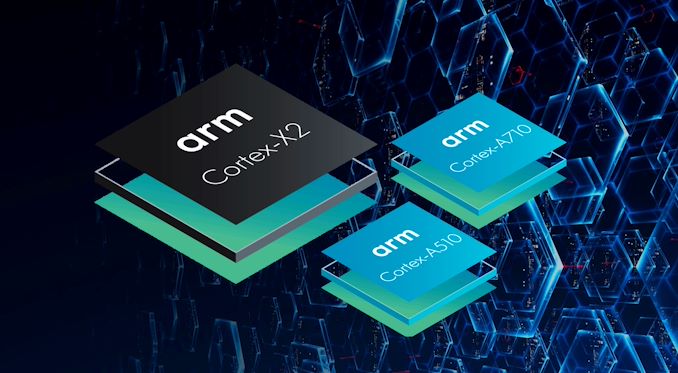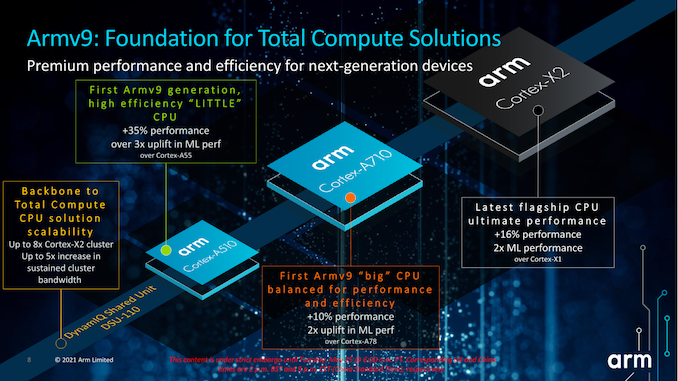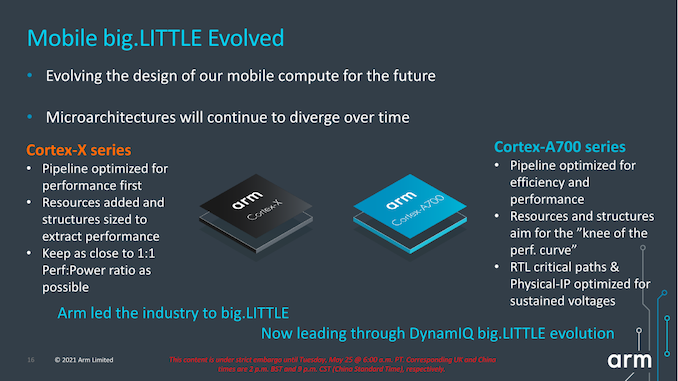Arm Announces Mobile Armv9 CPU Microarchitectures: Cortex-X2, Cortex-A710 & Cortex-A510
by Andrei Frumusanu on May 25, 2021 9:00 AM EST- Posted in
- SoCs
- CPUs
- Arm
- Smartphones
- Mobile
- Cortex
- ARMv9
- Cortex-X2
- Cortex-A710
- Cortex-A510

It’s that time of the year again, and after last month’s unveiling of Arm’s newest infrastructure Neoverse V1 and Neoverse N2 CPU IPs, it’s now time to cover the client and mobile side of things. This year, things Arm is shaking things up quite a bit more than usual as we’re seeing three new generation microarchitectures for mobile and client: The flagship Cortex-X2 core, a new A78 successor in the form of the Cortex-A710, and for the first time in years, a brand-new little core with the new Cortex-A510. The three new CPUs form a new trio of Armv9 compatible designs that aim to mark a larger architectural/ISA shift that comes very seldomly in the industry.
Alongside the new CPU cores, we’re also seeing a new L3 and cluster design with the DSU-110, and Arm is also making a big upgrade in its interconnect IP with the new cache coherent CI-700 mesh network and NI-700 network-on-chip IPs.
The Cortex-X2, A710 and A510 follow up on last year's X1, A78 and A55. For the new Cortex-X2 and A710 in particular, these are direct microarchitectural successors to their predecessors. These parts, while iterating on generational improvements in IPC and efficiency, also incorporate brand-new architectural features in the form of Armv9 and new extensions such as SVE2.
The Cortex-A510, Arm's new little core, is a larger microarchitectural jump, as it represents a new clean-sheet CPU design from Arm’s Cambridge CPU design team. A510 brings large IPC improvements while still having a continued focus on power efficiency, and, perhaps most interestingly, retains its characteristic in-order microarchitectural.
An Armv9 CPU Family – AArch64 only for all practical purposes*
The new CPU family marks one of the largest architectural jumps we’ve had in years, as the company is now baselining all three new CPU IPs on Armv9.0. We've extensively covered the details of the new Arm architecture back in late March. Cornerstone features of the new ISA include the new enrollment of prior optional/missing Armv8.2+ features that weren’t guaranteed in mobile and client designs (mostly due to the older A55 cores), and the introduction of new SVE2 SIMD and vector extensions.
One big change we’ve been expecting for quite some time now is that we’ll be seeing a deprecation of the 32-bit AArch32 execution mode in upcoming Arm Cortex-A mobile cores. The clock has been ticking for 32-bit apps ever since Google’s announced in 2019 that the Google Play store will require for 64-bit app uploads, and the company will stop serving 32-bit applications to 64-bit compatible devices later this summer
While Arm is declaring that shift to happen in 2023, for all intents and purposes it’s already happening next year for most global users. Both the Cortex-X2 flagship core and the Cortex-A510 little cores are AArch64-only microarchitectures that are no longer able to execute AArch32 code.
With that said, sharp readers will note that two out of three CPUs isn't a complete shift, and the reason for that is because the Cortex-A710 actually still supports AArch32. Arm states that the reason for this is primarily to meet the needs of the Chinese mobile market, which lacks the homogeneous ecosystem capabilities of the global Play Store markets, and Chinese vendors and their domestic app market require a little more time to facilitate the shift towards 64-bit only. This means we’ll have an odd scenario next year of having SoCs on which only the middle cores are able to execute 32-bit applications, with those apps being relegated to the middle A710 cores and missing out on the little A510 cores’ power efficiency or the X2 cores’ performance.
On the big core side, the new Cortex-X2 and Cortex-A710 are successors to the Cortex-X1 and Cortex-A78. Both designs are mostly designed by Arm’s Austin design team, and represent the 4th generation of this microarchitecture family, which had started off with the Cortex-A76 several years ago. These cores should be the last of this microarchitecture family before Arm hands things off to a completely new design with next year’s new Sophia cores.
In terms of design philosophy, the X2 and A710 generally keep the same overarching goals the X1 and A78 had defined: The X-series continues to focus on advancing performance by increasing microarchitectural structures and by Arm being willing to make compromises on power within reasonable limits. Meanwhile the A710 continues to focus on advancing performance and efficiency through smarter design and with a large focus on maximizing the power, performance, and area (PPA) balance of the IP.
One point Arm makes in the above slide is having optimized critical paths and physical design for sustained voltage operations – this is more of a goal the company is striving for in the next generations of “middle” cores rather than something that’s specifically reflected in the Cortex-A710.
This year, we are also finally seeing a new little core. We had covered the Cortex-A55 back in 2017, and since then we haven’t had seen any updates to Arm’s little cores, to the point of it being seen as large weakness of last few generations of mobile SoCs.
The new Cortex-A510 is a clean-sheet design from Arm’s Cambridge design team, leveraging a lot of the technologies that had been employed in the company’s larger cores, but implemented into a new in-order little microarchitecture. Yes – we’re still talking about an in-order core, and Arm still sees this to be the best choice in terms of extracting the best efficiency and “Days of use” of mobile devices.
Even though it’s a in-order core, Arm made a comparison that the new design is extremely similar to a flagship core of 2017 – namely the Cortex-A73, achieving very similar IPC and frequency capabilities whilst consuming a lot less power.
The new design also comes with a very interesting shared complex approach and shares the L2 and FP/SIMD pipelines with a second core, a design approach Arm calls “merged core” and undoubtedly will remind readers of AMD’s CMT approach in Bulldozer cores 10 years ago, even though there are quite important differences in the approaches.














181 Comments
View All Comments
name99 - Tuesday, May 25, 2021 - link
Inrinsity was about circuit design.PA Semi was about microarchitecture.
There was a *lot* of good stuff in PA Semi! I have looked quickly at quite a few of the Intrinsity patents, but I don't know enough about that level of the stack to have any option as to how impressive they were. (This is not a criticism -- even if all that was picked up from Intrinsity was a number of competent engineers capable of implementing the micro-architecture ideas of the PA Semi folks, that's an essential part of shipping a chip!)
I'd honestly love someone who is familiar with the circuit level to look at the Intrinsity (low level and PA Semi patents, like for a new register file design) and let us know an informed opinion.
But as important as both of these has been Apple's willingness to keep pushing the envelope, to keep pouring money into design, to keep taking risks (every design change is a risk...) and not to accept "good enough". That might seem obvious except that, of course,
- Intel has been cruising on "good enough" for 10 years,
- QC (notoriously) made "good enough" its official response to the A7, and followed that up by cancelling Centriq, and
- ARM, for whatever reason, seems to alternate between designs that look like they're trying to at least approach Apple, and designs that feel like "good enough.
melgross - Tuesday, May 25, 2021 - link
Intrinsity was about efficiency. That was what they were known for.mode_13h - Wednesday, May 26, 2021 - link
> anyone in the non-iOS space is stuck with this attempt to inject some> Bulldozer design features into the tired in-order A55 lineage.
Well, they can have just one core per complex, instead of 2.
I'm not really sure why the hate, unless you think you're going to be running a lot of FP/vector threads.
melgross - Thursday, May 27, 2021 - link
That was the problem with Bulldozer. They made the same mistake.mode_13h - Saturday, May 29, 2021 - link
> That was the problem with Bulldozer. They made the same mistake.You mean the 2 cores per complex? But ARM is giving customers the option to order up an A510 with just 1 per complex, if you think you need enough FP/vector throughput to warrant it.
I think a lot of the hate being directed at the A510 is mere guilt by association. It's massively different than Bulldozer, but the sharing of that one feature really seems to have tainted it with all the negative feelings people have towards Bulldozer.
lemurbutton - Tuesday, May 25, 2021 - link
x86 is dead.AMD doing 5% to 15% improvements every year.
Intel doing -5% to 10% every year.
Meanwhile, Apple & ARM are doing 10 - 20%+ every year and including accelerators like machine learning.
M1 runs circles around anything AMD and Intel have. M1X and M2 will allow Apple to claim performance wins across all consumer computing devices. Can't wait for the 32/64 core Mac Pros too. It's going to be ugly for AMD/Intel.
SarahKerrigan - Tuesday, May 25, 2021 - link
I would be hesitant to lump in Apple and ARM, given how far apart the highest-performing shipping licensables and the highest-performing shipping Apple cores are.ARM is still a long way from matching peak AMD or Intel ST (not merely iso clock, where they do okay, but absolute) in any shipping product, and honestly, neither A710 nor X2 look especially groundbreaking. A510 looks really good, but mixed with a certain amount of "well, about frigging time."
ikjadoon - Tuesday, May 25, 2021 - link
I agree on point 1, sadly. The X1 earns 40 points on SPEC2006 1T Geomean, while the A14 broke 70 points and A13 is 59 points.The X2 vs A15 battle will be interesting in terms of power, but the X2 will likely be slower than the A13.
On the second, isn’t the A510 four years late and it has an almost identical power vs performance curve to the A55? Personally, I thought it was the smallest and saddest announcement today.
The only genuine A510 improvement is at the A55’s worst position / peak power: 10% faster for 20% less power. That’s four years later.
The rest of A510 power vs performance is by ramping up the power budget. That +10% perf for -20% power = 37.5% increase in perf-power over four years = 8% perf-power improvements per year. ;(
If they are sticking with in-order, I hoped the A510 could’ve done something more over four years.
Raqia - Tuesday, May 25, 2021 - link
Apple will rule the roost for the next year, at least until Nuvia's Phoenix cores make their debut some time in the second half of 2022 (that announced timeline likely means the design has taped out...) The cache hierarchy of Apple CPU complexes is simpler and fewer in level than what ARM's is capable of, which reflects the scope of their respective ambitions. ARM's hierarchy hobbles performance at mobile device scales but has much more headroom for supercomputing or server scale compute.Wilco1 - Tuesday, May 25, 2021 - link
Your numbers are off. AnandTech's SPECINT2006 results are 63.34 for A14 and 41.3 for SD888: https://images.anandtech.com/doci/16463/SPEC-power...TSMC 5nm offers ~15% speedup over 7nm, so 3.3-3.5GHz may be feasible (compared to 3.1GHz for SD865+ on 7nm), and that should get Cortex-X2 scores in the high 50's, close to the A14.
As for efficiency, it's unrealistic to expect major gains when starting from an already very efficient design. It's the same with performance, you can't expect a doubling of ST performance every few years like in the past.